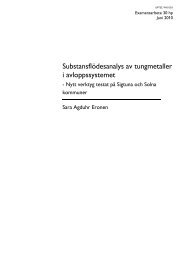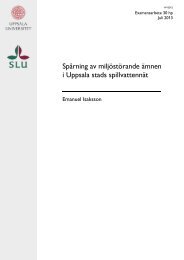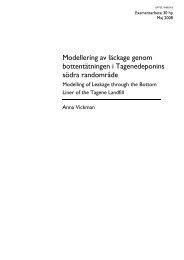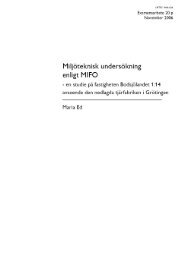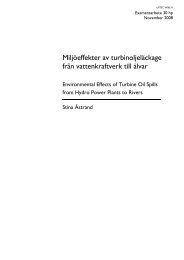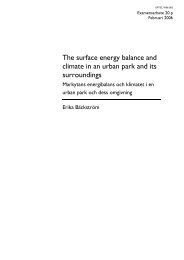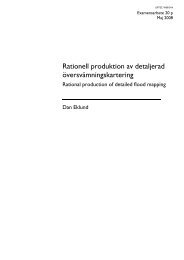Nutrient Transport Modelling in the Daugava River Basin - DiVA Portal
Nutrient Transport Modelling in the Daugava River Basin - DiVA Portal
Nutrient Transport Modelling in the Daugava River Basin - DiVA Portal
Create successful ePaper yourself
Turn your PDF publications into a flip-book with our unique Google optimized e-Paper software.
3.2 MODEL DESCRIPTION3.2.1 An overview of <strong>the</strong> modelThe GWLF model simulates monthly stream flow and monthly loads of phosphorus andnitrogen from any watershed. Hydrology is <strong>the</strong> driv<strong>in</strong>g force of <strong>the</strong> model. There arethree types of water storage; soil water (unsaturated zone), shallow groundwater(groundwater box 1) and deeper groundwater (groundwater box 2). The amount ofwater <strong>in</strong> <strong>the</strong>se three storages characterises <strong>the</strong> system at each moment and determ<strong>in</strong>es<strong>the</strong> evapotranspiration, surface runoff and groundwater flows. The catchment is divided<strong>in</strong>to land use categories with different characteristics (different parameter values).Surface runoff from each land use area and groundwater flow from <strong>the</strong> entire catchmentto <strong>the</strong> river are predicted from data on daily precipitation and temperature. The user hasto state <strong>the</strong> nutrient concentration <strong>in</strong> surface runoff, groundwater and <strong>in</strong> eroded material.The nutrient load is obta<strong>in</strong>ed by multiplication of <strong>the</strong> nutrient concentration by <strong>the</strong> waterflow. Po<strong>in</strong>t sources of nutrients are added <strong>in</strong> order to obta<strong>in</strong> <strong>the</strong> total nutrient load. In<strong>the</strong> orig<strong>in</strong>al GWLF model <strong>the</strong> nutrient load from septic systems <strong>in</strong> <strong>the</strong> catchment is<strong>in</strong>cluded. This part of <strong>the</strong> model has been excluded <strong>in</strong> <strong>the</strong> study due to difficulties withf<strong>in</strong>d<strong>in</strong>g data on <strong>the</strong> number of people that have different k<strong>in</strong>ds of septic systems. Figure4 shows a schematic picture of <strong>the</strong> model.EvapotranspirationPrecipitationLand usecharacteristicsTemperatureInput dataInfiltrationSnowmeltFunctionSoil water(unsaturatedzone)Nutr.conc.<strong>in</strong>erodedmaterialErosionSurfacerunoffNutr. conc. <strong>in</strong>surface runoff(land usespecific)Water storagePercolationOutputNutr. conc. <strong>in</strong>box 1Groundwaterbox 1r1Po<strong>in</strong>tsourcesPercolationNutr. conc. <strong>in</strong>box 2Groundwaterbox 2r2StreamchannelStreamflow<strong>Nutrient</strong> loadFigure 4. The structure of <strong>the</strong> modified GWLF model used <strong>in</strong> this study.The model calculates flows and nutrient loads for each land use and <strong>the</strong> contributionsfrom <strong>the</strong> different land uses are summed up <strong>in</strong> order to obta<strong>in</strong> <strong>the</strong> total flow/load from<strong>the</strong> watershed. In Appendix A <strong>the</strong>re is a list of all <strong>the</strong> <strong>in</strong>put data and parameter valuesused <strong>in</strong> this study.8



